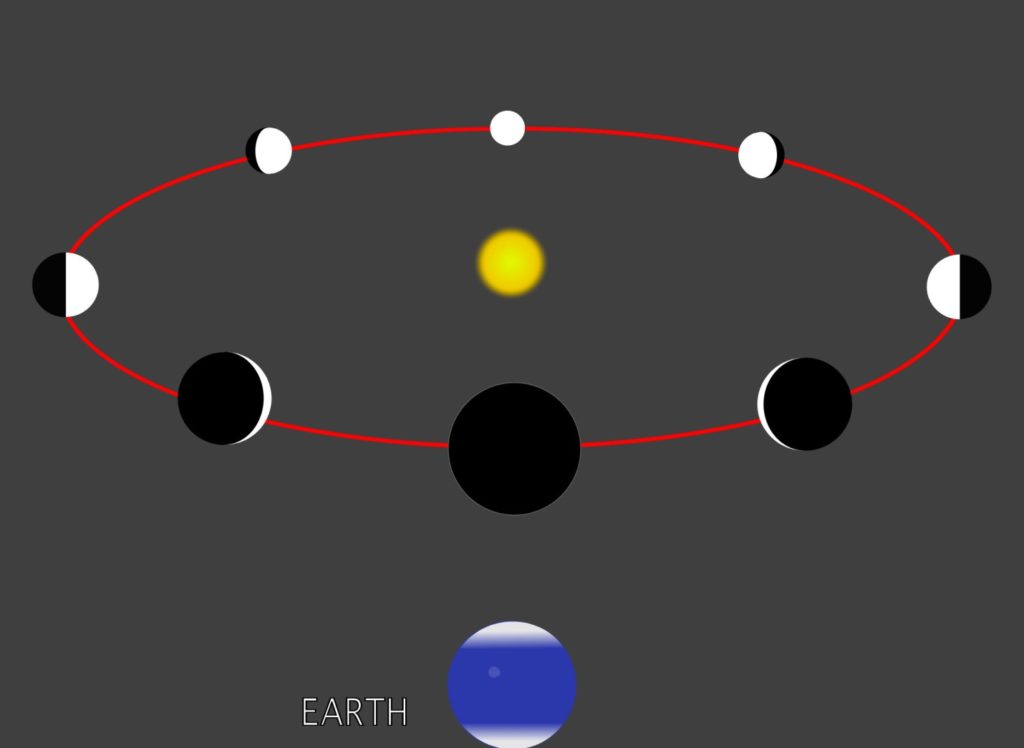Sky Report May 11 – May 17

Venus has been the “Evening Star” star since October, and regular star-gazers have gotten used to seeing it high in the west after sunset, but enjoy it while you can – this month it disappears, and in June it reappears in the morning sky where we’ll call it the “Morning Star”.
To early people this disappearance and reappearance was totally puzzling. We now know that Venus orbits on a path inside the earth’s orbit, and because it’s moving faster around the sun it periodically catches and passes us. The attached diagram should make that clear. As it approaches us it appears to grow larger, and at the same time the angle it makes with the sun decreases, so it sets earlier and becomes a larger and slimmer crescent.
Look for Venus in the west as the sky is growing dark. You can see it well before sunset if you know where to look, especially if you use binoculars. But look early as Venus sets four minutes earlier each night; on the 11th it sets at 11:08 p.m. and on the 17th at 10:39 p.m. – assuming you are looking out over the ocean without hills or other obstructions to block your view of the true horizon.
With even a small telescope you’ll see that Venus has phases, like our moon. It’s now a thin crescent growing thinner by the day.
Venus is the sole planet in the evening sky but three others are in the morning sky, and they are, from right to left, Jupiter, Saturn, and Mars. The best time to look is around 5 a.m. when all three are reasonably high in the southeast. Jupiter is by far the brightest, outshining every star in the sky, so you can’t miss it. Saturn is a short distance – less than five degrees — to the left of Jupiter, and it’s as bright as the brightest stars, while Mars is much farther to the left and is the same brightness as Saturn. Note that Saturn has a soft cream color while Mars is slightly orange.
The moon passes these three planets this week. On the morning of the 12th it is a short distance below Jupiter, and hence not far from Saturn too; on the morning of the 13th it is roughly midway between Saturn and Mars; on the morning of the 14th Mars is to the left of the moon and on the following morning Mars is to the upper right of the moon. The moon is at its third-quarter phase on the 14th, and that is when it has traveled three-quarters of the way around the earth since it was new three weeks earlier.
Recently discovered Comet SWAN has become bright enough to see with binoculars in the morning sky. This week and next it’s very low in the east-north-east at 5 a.m. and if your horizon is blocked by hills you won’t see it, so it is essential to have an unobstructed view of the sky. Look for it only a few degrees above the horizon with binoculars. It is in Pisces from the 11th through 14th and then in the small constellation Triangulum on the 15th through 18th — two constellations without bright stars to guide the way. If it continues to brighten as predicted it should be visible to the naked eye. For a finder chart, go to www.heavens-above.com, enter your coordinates below the map (Kanab is 37.04°, -112.53°), locate the comet from the list, and enter the date and time you will look for it.
The Sky Report is presented as a public service by the Stellar Vista Observatory, a nonprofit organization based in Kanab, Utah, which provides opportunities for people to observe, appreciate, and comprehend our starry night sky. Additional information is at www.stellarvistaobservatory.org. Send questions and comments to John@StargazingAdventures.org.






Comments are closed.